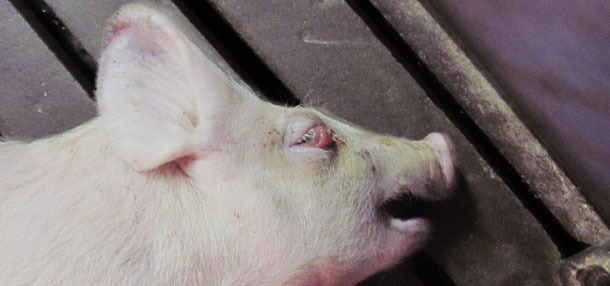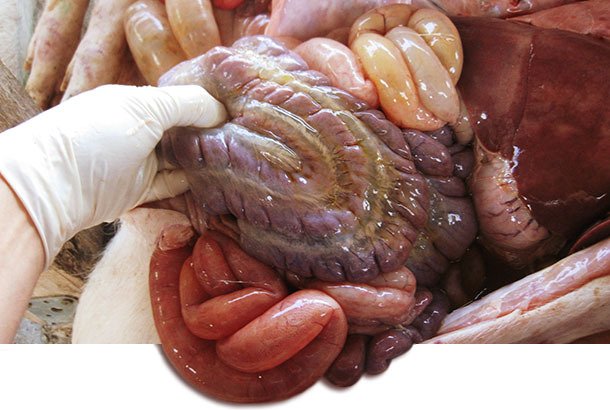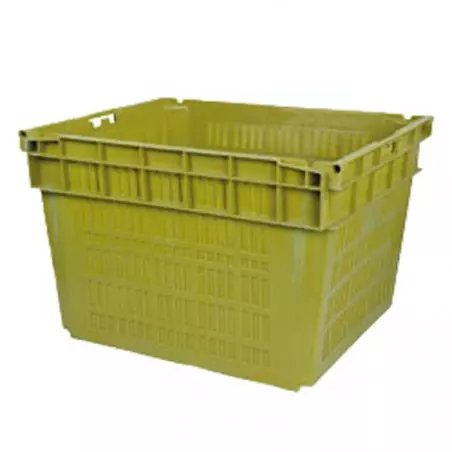The farm management operated a cooperative farm system in central Europe with breeder farms linked to various production pig nursery and finisher units. The breeder pigs and young piglets all received a complete vaccination programme. Some farms were positive for European strains of PRRS, while others remained negative. The weaned piglets were moved to separate nursery production pig sites at 3 to 4 weeks-old, in batch sizes of around 800 piglets.
The farm system received feed for the nursery and finisher production pigs from a large feed mill operation in various phases – nursery starter, grower and finisher feeds. The management of this feed mill decided to reduce the in-feed doses of antibiotics and Zinc oxide added to the post-weaning starter diets, with Zinc oxide reduced from 2,500 ppm to 150 ppm.

Soon after this, the managers of the nursery sites noticed some nervous signs amongst many of the recently weaned pigs. There was also a moderate increase in the mortality levels for the nursery period, from 3 to 4 %, up to 5 to 6 %. The problem occurred in different batches of piglets, over a period of months.
Close examination indicated numerous weaner pigs displayed a range of nervous signs and depression. These clinical signs usually started 7 to 14 days after weaning from the sow, and seemed to affect particularly the larger and better-growing pigs. Each outbreak of disease in each batch of pigs appeared to last about 2 weeks, with pigs recovering at around 7 weeks-old.
The nervous signs included uncoordinated ataxia (stumbling about), recumbency (lying down), and convulsions. Besides the nervous signs, many of the sick pigs had marked soft tissue swelling (oedema) of the upper and lower eyelids (see Figure 1).

Figure 1. Five week-old weaner pig with recumbency and eyelid oedema.
Occasionally, affected pigs also had an amazing change in their normal vocalization sounds, from the usual strong squealing sound, into a high-pitch squeaky voice. This was often noticeable when the affected pigs were picked up for handling.
The worst affected pigs died after an illness of about 1 to 3 days duration. At autopsy of some affected pigs, the soft gelatinous oedema was evident in the eyelids, but also in the meso-colonic area of the spiral colon (see Figure 2), and in the wall of the stomach. The pericardial sac of some pigs had excess fluid content. The head and intestines of some pigs were submitted to the pathology and microbiology laboratory for testing.

Figure 2. Autopsy of affected nursery pig, with oedema of meso-colon.
The farm responded to the disease situation by assessing that the humane handling of their pigs required implementing antibiotic programs, consisting of colistin and apramycin products in premix formulations into the nursery starter diets. The humane handling and care of these nursery pigs also required that the Zinc oxide levels in the starter diets be replaced to levels of 2,000 to 3,000 ppm.
Key features

- Seven to 14 days after weaning – specific age range affected.
- Wide range of nervous signs, including change in vocalisation.
- Oedema of eyelids, stomach wall and colon.
Comments on case study
This is oedema disease of pigs, which is caused by strains of entero-toxigenic Escherichia coli (ETEC) bacteria that contain a specific vero-toxin (shiga-like toxin). These bacteria are located in the nursery farm environment and are ingested by the piglet soon after weaning. The bacteria then attach in colonies on the small intestine epithelium and their vero-toxins cause blood vessel disturbances in the brain and other locations in the pig. The E coli vaccines used in breeder pigs are aimed to provide immunity against ETEC in neonatal piglets and do not protect against ETEC infections in post-weaned pigs – that is once the pigs stop consuming milk and maternal antibodies.
Culture of intestine samples in a bacteriology laboratory will show heavy pure growth of the ETEC, which may show haemolysis on blood agar growth. The type of E coli causing oedema disease is usually of the F18 fimbrial type and contains the shiga-like toxin Stx2e. These virulence factors can be confirmed by laboratory testing with specific PCR reactions and agglutination tests.
Histopathology of the brain will demonstrate degenerative vasculitis and peri-vascular haemorrhages particularly in the brain stem. The brain will lack inflammatory changes, such as those noted in cases caused by Streptococcus meningitis or water deprivation.
Treatment of piglets affected clinically with oedema disease can be assisted with the antibiotic colistin, which is often regarded as the drug of choice, with only a low level of resistance among E coli and Salmonella. Colistin may be administered via feed or water delivery. For example, 10% premix formulations may be added to feed at 100 g per tonne of completed feed. Zinc oxide should be replaced back into the post-weaning starter diets at pharmaceutical levels. The occurrence of clinical ETEC infections in post-weaned pigs had dropped away to a very low level since the 1980’s with the introduction of in-feed Zinc oxide at sufficient pharmaceutical levels (1,500 to 3,000 ppm) in early nursery starter diets. Zinc oxide has a specific anti-bacterial action damaging and distorting bacterial membranes with leakage of bacterial contents. There is an on-going critical discussion among European activists and authorities on limiting the usage of antibiotics and Zinc oxide for control of animal diseases. There has been a consequent rise in attempts to find safe, effective and cost-neutral alternatives to these proven compounds.
E coli and ETEC strains are common background organisms that are considered to be “embedded” in most pig farms, presumably in materials in the pens, walkways and slurry. This embedded nature explains its constant nature of occurrence and outbreaks when appropriate control measures are not taken. Studies across Europe indicate that 20 to 35 % of farms contain the F18 strains of E coli embedded in their systems. In this case study, the reduction of zinc oxide usage away from appropriate pharmaceutical levels therefore quickly led to outbreaks of clinical E coli infections. The nursery areas that are old and dirty will be a reservoir of infection, if they are not cleaned properly. Cleaning of nursery areas must include the initial use of detergents, prior to use of washing and disinfectants. The amount of faeces material (slurry) underneath weaner pens needs to be managed properly.
Another long-term control measure that has been recently introduced is the availability of an E coli vaccine intended for use against oedema disease strains of E coli. This genetically modified vaccine is delivered to piglets at 4 days old. It does not prevent colonisation but raises antibodies raised against the Stx2e shiga-toxin, neutralising the pathogenic effects of the key verotoxin involved in oedema disease.






